Sugar’s
Sugar’s was located at 201 East Fourth Street in St. Paul, across from the Union Depot.
THE WANN BUILDING
Fortunately, this building was the subject of a City of St. Paul Heritage Preservation Commission Staff Report in conjunction with applications to renovate the building. The application is full of information and photos.
The brick building was built in 1879 (described as new that June in a tale of a teenage robbery). Wann was John Wann, described by the Minneapolis Daily Tribune on August 23, 1874, as “an old and wealthy citizen, whose name is a guarantee of good faith and honesty wherever it is known.” Wann had a lot of money and a lot of property and apparently spent most of his time buying, selling, and building on it. This particular building was designated for the wholesale drug company Noyes Bros. & Cutler. Wann was also involved with a great number of lawsuits, although they may have had to do with his development activities. He finished building his “block” along the north side of Fourth Street between Sibley and Wacouta, as reported by the St. Paul Globe on December 31, 1881.
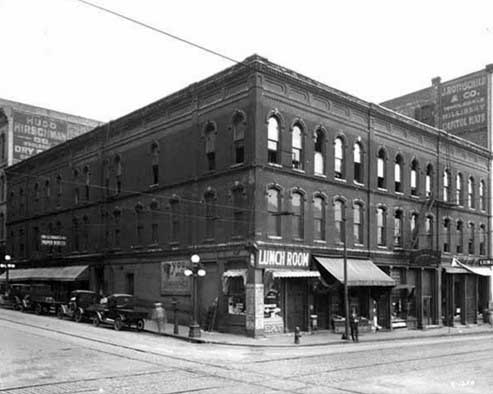
Wann Building before 1926. Photo courtesy Minnesota Historical Society.
A fire nearly destroyed the Wann Building, whose address was reported as 352 Sibley Street, on December 13, 1895. This became the address of the Straus Knitting Mills. Damage was estimated at $100,000. There were no fatalities. The roof of the building was burned off and the top floors were destroyed.
There was a fire in the building in 1903, but the news report did not list a lunch room or cafe as one of the seven merchants affected. One was a liquor store, and 207 E. Fourth Street was a hat shop, the proprietor of which had let his insurance lapse just a week prior.
It appears that the corner space was traditionally a lunch room, used heavily by the businesses in the area as it grew. Unfortunately this photo is too low-resolution to read the name of the lunch room.
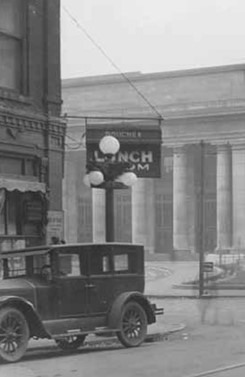
Photo courtesy St. Paul Heritage Preservation Commission Report.
John Wann died on August 23, 1905, leaving an estate of $181,000 to his widow. $180,000 of that was in real estate. His two daughters had moved to Germany and married Germans. His son lived in St. Paul.
1926
The building received a new façade in 1926 and clear historic photos of the 1926 storefronts have not been found. The entire 1879 exterior was removed as part of the 1926 renovation and replaced with an industrial window, storefront, and brick windows. The storefronts have been replaced many times since 1926 and historic images from 1926 are at a slant and difficult to see.
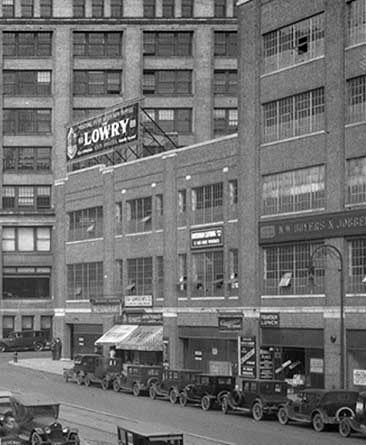
Wann Building after 1926 renovation. Photo courtesy Minnesota Historical Society
JOE DOTTY’S CAFE
After a number of searches under several names and addresses, the common denominator turns out to be Joe Dotty. Some of these different addresses and names may be errors in reporting. Chronologically we have:
In December 1943, as the operator of the Cozy Corners Cafe, Joe was given probation for selling Oleomargarine as butter. A more serious charge was that he was taking uneaten food off people’s plates and making something else out of them and selling it. That is kind of vague, but he was fined $25 for selling food that was not fit for human consumption.
In July 1944, he was identified as the proprietor of the Fountain Bar at 207 E. Fourth Street.
In June 1945, still at 207 E. Fourth Street, one reporter called Joe’s place the Stop Over Lunch, which a couple of robbers did.
In July 1945, he was identified as the proprietor of the Fountain Lunch at 207 E. Fourth Street. This was the scene of an ugly incident where a drunk and distraught patron was upset about being asked to leave at closing time, took out a knife he used to fix shoes, and slashed the bartender to death. Not realizing his bartender was hurt, Joe shut the door on the assailant, and the police had to track him down. He got 7 to 30 years at Stillwater.
By October 1945, the place was being referred to as Joe Dotty’s Cafe, although some lazy reporters misspelled it as Joe Doty’s Cafe.
SUGAR AND TINY
Sugar was Alex Viner, who was born to Russian parents who came to America in 1903. For some reason he wrote that he was born in Wells, MN on his World War II registration card in October 1940, but on all other Census forms it says that he was born in New York, in 1906. In 1920 his father was a bellboy at a hotel.
In 1935, the St. Paul directory shows that Alex Viner was the manager of the B & R Tavern at 645 Selby Ave.
Sometime between April and October, 1940, Alex married Arline “Tiny” Minnie Moberg. Tiny’s father was Swedish and had come to America in 1906; her mother was American-born. Tiny was born in 1913 and was a working girl – she was a “packer” in 1937, and “cutter of frost shields” in an automotive appliance factory just before she got married.
In October 1940, Sugar owned the Trocadero Cafe at 375 Wabasha, as he reported to the draft board.
SUGAR’S
At some unknown time between 1945 and 1950, the tavern at 201 E Fourth Street became known as Sugar’s. It was run by Sugar and Tiny, and was known for its fish fries, mashed potatoes, and onion rings. They would cash payroll checks for surrounding companies such as Toni, Rayette, the Great Northern Depot, the Post Office, and Straus Knitting Mills. All kinds of people would be seen in the bar/restaurant, and some employees would work 30 years or more.
Sugar died young, on May 10, 1950. Here is his headstone, via Findagrave.com Notice that it has a birth year of 1908, although he gave his birthdate as May 14, 1906 on his draft registration card.
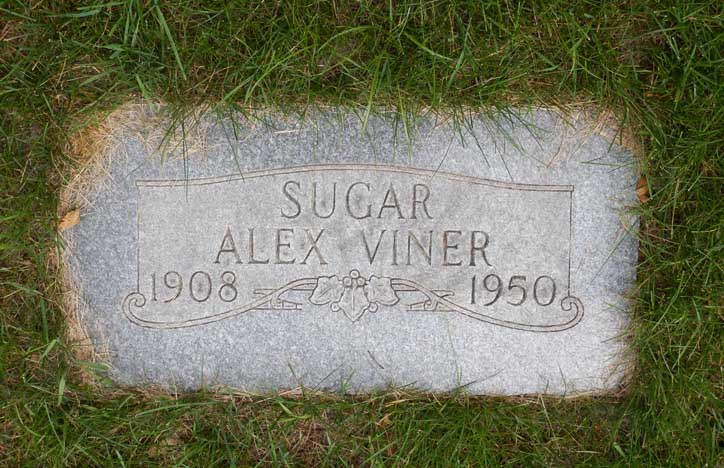
Courtesy Findagrave.com
Tiny carried on, with the help of managers Al and Libbie Sabes. In her obituary, Libbie was identified as a part owner until she retired. She died in 1975, at the age of 65.
Also helping out were the children of Sugar and Tiny:
- Connie, born in 1938
- Jimmy, born in 1943
- Ronnie, born in 1946
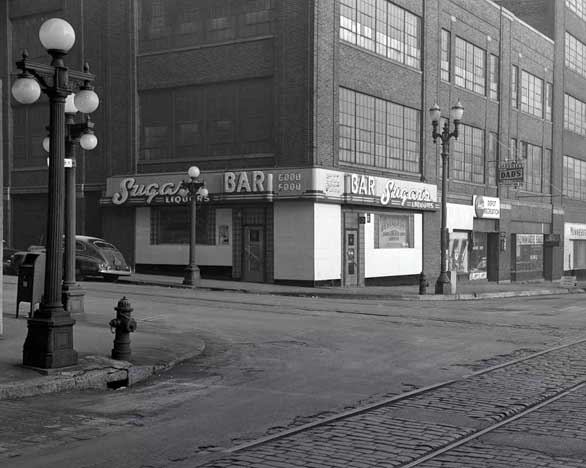
December 20, 1954 photo courtesy Minnesota Historical Society via Lyfmap.com
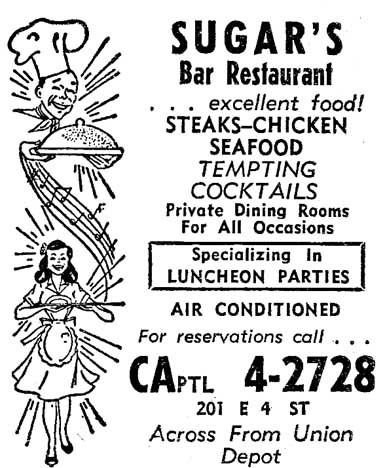
1956 ad courtesy Ron Ciccone
KID CANN AT SUGAR’S
Isadore Blumenfield, known as Kid Cann, was the most notorious gangster in the Twin Cities, but never seemed to do any time for any of his alleged crimes. He was accused of murdering journalist Walter Liggett in 1936, but dodged that charge. He ran the Minneapolis bootlegging Syndicate, but the Feds couldn’t catch him on that either. And he was certainly involved with the looting of the Twin City Transit’s streetcar system, but if he did the crime, others did the time. The only time he was caught with his pants down was for was for a Mann Act violation: persuading, inducing, enticing or coercing any woman to go from one place to another in interstate commerce, for the purpose of prostitution or debauchery, or for any other immoral purpose, whether with or without the consent of the woman. (Title 18, U.S.C.A. Section 2422).
Well, the Kid (or Fergie, as he preferred to be called), did a dumb thing. In May 1956, he spoke to a prostitute on the phone, and she flew from Chicago to Minneapolis and met him at the Kenesaw Bar on Skid Row. He told her to go to the Dyckman Hotel where he had made a reservation for her, and for $200 she did things she shouldn’t a oughta done.
In February 1957, she went before the Grand Jury and denied ever doing those nasty things. After perjuring herself, she went to Sugar’s Bar, where she met Fergie’s friend and told him what she had told the Grand Jury. The friend then called Fergie and all met back at the Kenesaw Bar where they told Fergie what she said. Her testimony didn’t hold water, since she had been a prostitute since 1953, was an alcoholic, had flown all over the country to ply her trade, and Fergie, through the friend, bailed her out of many bounced checks.
The upshot was that Fergie – Kid Cann – was finally convicted (of the Mann Act and conspiracy), and given the sentence of two years in prison and a fine of $2,500. The friend was found guilty of conspiracy and sentenced to a year and a day in prison for conspiracy.
And the prostitute? I don’t know if she ever went back to Sugar’s bar, but she did get married (four times) and died at the age of 58.
MUSIC AT SUGAR’S
It’s difficult to find many references to music at Sugar’s, but there is an occasional comment that someone played in a band there. It does appear to be a fairly large place, so there seems to be plenty of room for a bandstand and dance floor.
Mark Youngblood did find a blurb from 1960 described it as the Northwest’s most popular, Ultra-Modern Piano Bar, featuring Bette Kent. It served “Delicious Cocktails and Tempting Foods.” The source of the text is unknown but looks like it comes from a visitors’ guide.
If you have any more information about music at Sugar’s, please contact me! Thanks!
FUN AT SUGAR’S
In addition to the great food and music, Sugar’s seems to have been a fun place, as evidenced by the many souvenirs that people have hung onto and posted on Facebook. Here are a few.
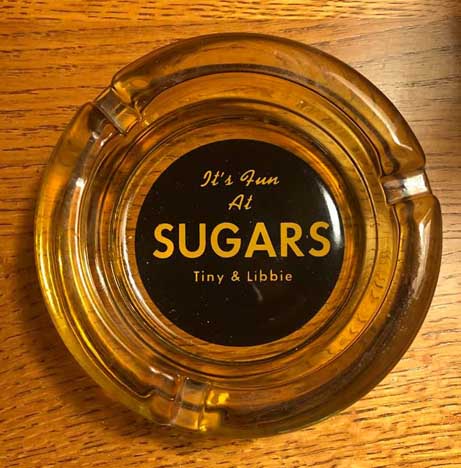
Ashtray posted by Jim Streadwick
Bottle opener/spinner posted by Ron Ciccone
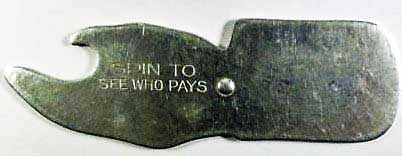
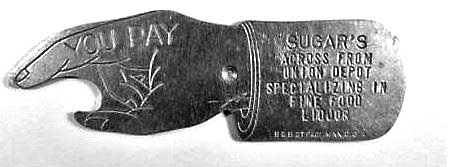
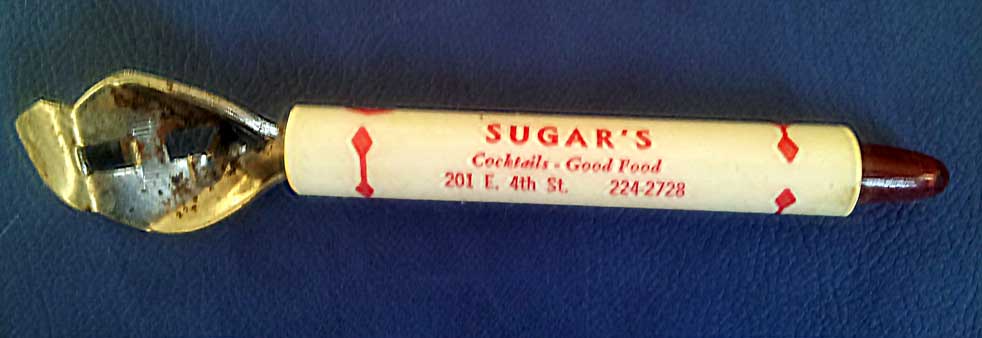
Bottle opener/phone dialer posted by Angelo Rulli
Matchbook image below courtesy Rick Schlosser
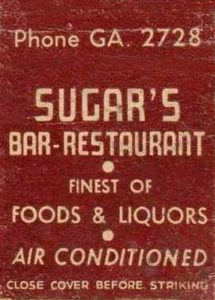
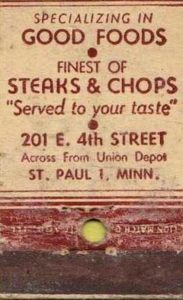
The end of Sugar’s came in October 1976, when it was purchased by Terry Ryan and was renamed Sibley Station. It underwent many other iterations since then, and now stands empty, ready for renovation into first floor businesses and upper floor flats. Dan Raschick took some photos of the interior demolition in about 2017 – this one shows the original brick of the building that somehow escaped the wrecking ball, to be used once again.
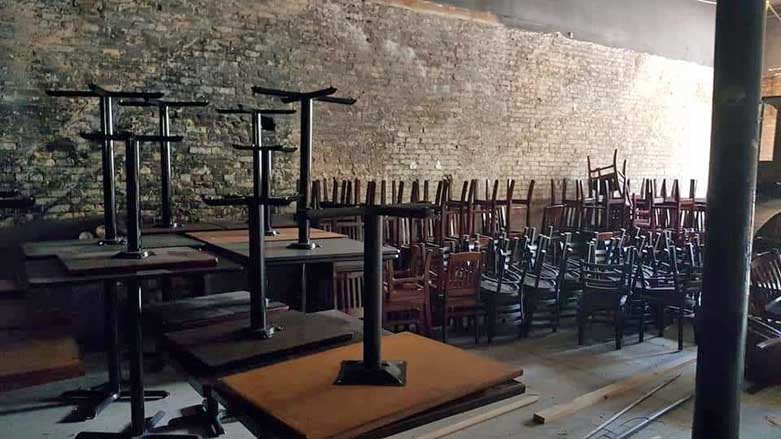
Courtesy Dan Raschick
